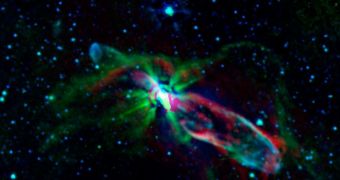Scientists at NASA were recently able to conduct a new series of observations of a nearby cosmic cloud called HH 46/47. The work revealed the emergence of a new baby star, and the process was clearly imaged using two of the world's most renowned telescopes.
Herbig-Haro (HH) objects are created by developing stars, which start releasing jets of radiations into the surrounding space. As these radiations and lights hit material in the stars' vicinities, they produce nebulous regions that are very bright despite their small size. HH 46/47 is such an object.
Located relatively close to Earth, the cosmic cloud was an easy target for the NASA Spitzer Space Telescope, which surveys the sky in infrared wavelengths, and the Atacama Large Millimeter/submillimeter Array (ALMA), which sees the sky at radio frequencies.
ALMA is the largest, newest, and most capable Earth-based radio observatory, and is currently being built high in the Chilean Andes. It is the result of a collaboration between Europe, the United States, Canada, East Asia and the Republic of Chile, and its total costs reach more than $1 billion (€745.9 million).
This unique combination of radio and infrared wavelengths was able to pierce the gas and dust clouds surrounding HH 46/47, revealing the inner dynamics of the region. The central star in the cloud was revealed to be producing twin supersonic jets from its poles, creating two massive lobes.
“Young stars like our Sun need to remove some of the gas collapsing in on them to become stable, and HH 46/47 is an excellent laboratory for studying this outflow process,” explains study investigator Alberto Noriega-Crespo.
“Thanks to Spitzer, the HH 46/47 outflow is considered one of the best examples of a jet being present with an expanding bubble-like structure,” adds the expert, who holds an appointment with the Infrared Processing and Analysis Center at the California Institute of Technology, in Pasadena, Calif.
The expert and his team have been studying this cosmic cloud for more than 10 years. They conduct all of their observations using Spitzer. The current study allowed them to refine their results even further, by adding ALMA's radio wavelengths to a composite image.
The radio study was conducted by experts at Yale University, and was led by astrophysicist Hector Arce. Details of the investigation were published in a recent issue of the esteemed Astrophysical Journal.

 14 DAY TRIAL //
14 DAY TRIAL //